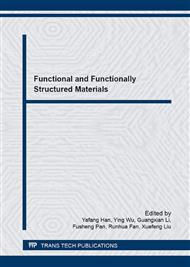[1]
S.Y. Luo, Y.C. Liu, C.C. Chou, T.C. Chen, Performance of powder filled resin-bonded diamond wheels in the zvertical dry grinding of tungsten carbide, J. Mater. Process Technol. 118(2001) 329-336.
DOI: 10.1016/s0924-0136(01)00861-5
Google Scholar
[2]
Zhou T, Wang X, Cheng P, Wang T, Xiong D, Improving the thermal conductivity of epoxy resin by the addition of a mixture of graphite nanoplatelets and silicon carbide microparticles, Exp. Polym. Lett. 7(2013) 585–94.
DOI: 10.3144/expresspolymlett.2013.56
Google Scholar
[3]
Chih-Chun Teng, Chen-Chi M. Ma, Kuo-Chan Chiou, Tzong-Ming Lee, Synergetic effect of thermal conductive properties of epoxy composites containing functionalized multi-walled carbon nanotubes and aluminum nitride, Composites Part B. 43(2012).
DOI: 10.1016/j.compositesb.2011.05.027
Google Scholar
[4]
Kiho Kim, Myeongjin Kim, Jooheon Kim, Thermal and mechanical properties of epoxy composites with a binaryparticle filler system consisting of aggregated and whisker type boronnitride particles, Compos. Sci. Technol 103(2014) 72-77.
DOI: 10.1016/j.compscitech.2014.08.012
Google Scholar
[5]
Yimin Yao, Xiaoliang Zeng, Kun Guo, Rong Sun, Jian-bin Xu, The effect of interfacial state on the thermal conductivity of functionalized Al2O3 filled glass fibers reinforced polymer composites. Composites Part A 69(2015) 49-55.
DOI: 10.1016/j.compositesa.2014.10.027
Google Scholar
[6]
Jae SikJi, Prediction of phonon and electron contributions to thermal conduction in doped silicon films. J. Mater. Sci. Technol 28(2014) 2287-2292.
DOI: 10.1007/s12206-014-0518-3
Google Scholar
[7]
Silverman E M, Product development of engineered thermal composites for cooling spacecraft electronics . Northrop Grumman Tech. Rev. J. 13(2005) 1-19.
Google Scholar
[8]
Kun-Hou Liao, Dillip K. Mishra, Chih-Ming Chuang, Jyh-Ming Ting, Large area vapor grown carbon fibermat and its composite. Composites Part B 42(2010) 1251-1256.
DOI: 10.1016/j.compositesb.2011.02.007
Google Scholar
[9]
H. Jang, K. Ko , S.J. Kim, R.H. Basch, J.W. Fash, The effect of metal fibers on the friction performance of automotive brake friction materials. Wear 256(2004) 406-414.
DOI: 10.1016/s0043-1648(03)00445-9
Google Scholar
[10]
Lin Ronghui, Wang Fengyuan, Li Shuyu, Sun Gangm Wang Guoyuan. Affection of Phenolic Resin Modified by Copper Nanoparticles on Friction & Wear Characteristics of Fraction Materials. Non-Metallic Mines, Chinese, 30(2007) 68-70.
Google Scholar


